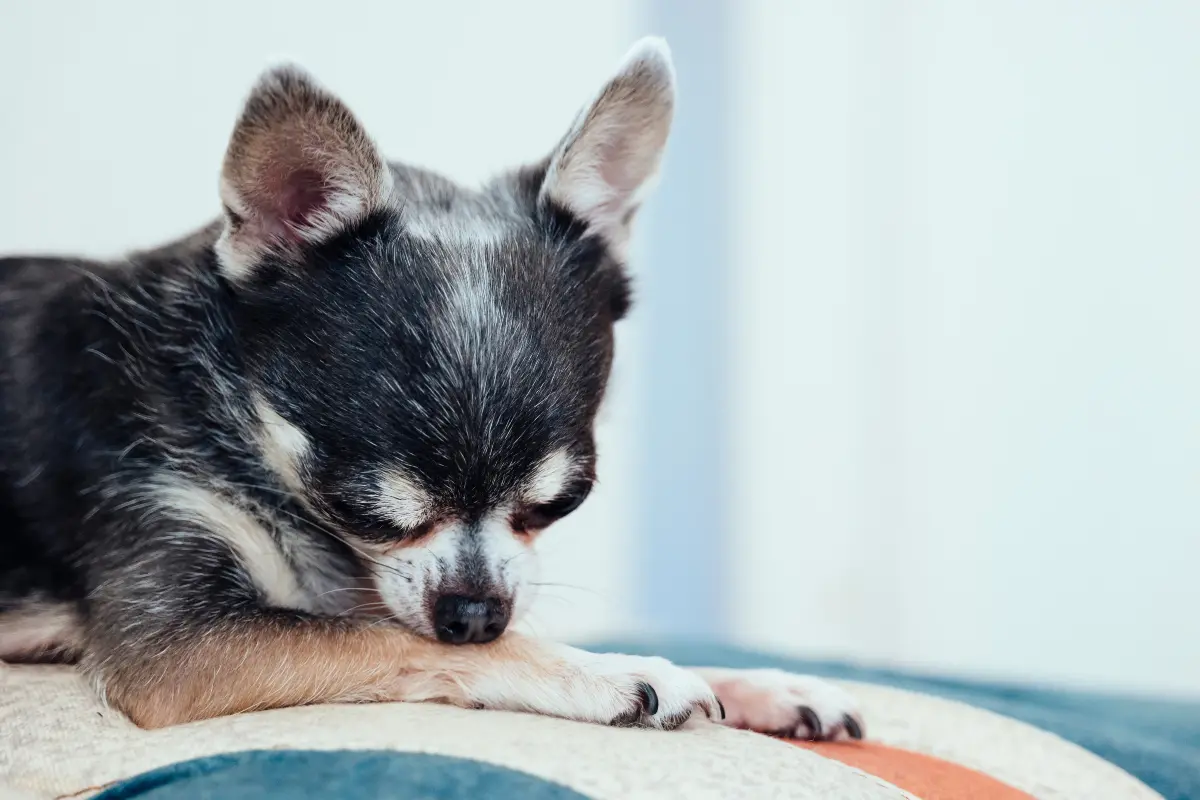
Don't let dog hot spots get your dog down. Learn everything you need to know to treat hot spots on your dog and keep his skin safe and healthy.
If you’re wondering how to treat a hot spot on a dog, you’re in the right place. Many dog parents wonder how to best treat their furry friend. Hot spots can be very painful for your pup, so, of course, you’ll want to get his skin feeling healthy again as soon as possible.
We’ve got you covered. This article will go over everything from what hot spots are, what causes a hot spot on a dog, how to best treat hot spots on dogs, and the best products to do so.
Your dog will be feeling as good as new soon, and you can rest assured you will walk away with everything you need to know to best treat hot spots on your dog.
What Are Hot Spots on Dogs?
Hot spots are formerly known as acute moist dermatitis. These are red, painful areas of infected skin. They are sometimes raised and appear to be irritated. Hot spots can appear quickly and usually come with some hair loss. They can grow larger in just a few days.
Dogs can get hot spots on any area of the body but are most commonly found on the hips, neck, limbs, or face. The appearance and the size of the lesions can slightly vary in location, but they mostly will look similar regardless of where the hot spots are located.
Hot spots on dogs can heal quickly and be relatively minor, but they do have the potential to become a serious issue, such as deep skin ulcerations or even widespread infection.
What Do Dog Hot Spots Look Like?
Hot Spots on Dogs are typically roundish red spots on your dog's skin. The spots will get bigger and more irritated if your dog licks them.
Hot spots on dogs can range in size. They are usually inflamed, raw and red. You may notice intermittent bleeding at the spot, but that doesn’t always occur. The area will become painful and moist. It typically will spread due to a dog scratching, licking, or chewing around the area.
Hot spots on dogs do have a unique look that is typically different from other skin conditions, including mange and ringworm, because the skin is very inflamed and moist.
What Causes Hot Spots on Dogs?
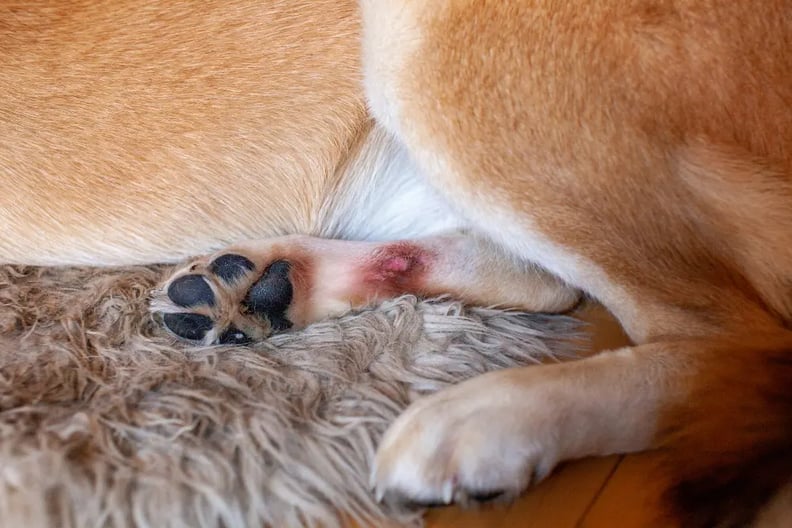
Treating hot spots isn't too complicated when you know what is causing them. Treating both the wound and the cause at the same time will help the spots heal faster and prevent them from coming back.
There are several common conditions that can cause dog hot spots. These include:
1. Food allergies
How you treat allergies will depend on the type. You may have to change up your dog’s food. You can document which foods help and which cause issues. Reach out to your veterinarian if necessary to help determine the best way to help your dog.
2. Flea allergies
Your dog may have adverse reactions to fleas. It’s critical to make sure your dog doesn’t have fleas and prevent them from occurring.
3. Seasonal allergies.
Yup, dogs get them, too. Seasonal issues are less common than food allergies, so it's important to rule those out first for proper treatment. Dogs may have seasonal allergies, including grass, pollen, mould, hay, fungi, and pests. You can help keep them healthy and comfortable with diet changes, digestion support, liver detox, and topical treatments.
4. Ear Infections
The yeast or bacteria from the ear canal can actually be so irritating that the dog scratches at it, which can create painful hot spots behind the ear, on the neck, or on the ear flap. Treating ear infections right away can help prevent secondary hot spots from occurring and keep your dog healthy and comfortable.
5. Moisture from Swimming
Excessive moisture from swimming is another common cause of hot spots on dogs. To prevent hot spots from occurring, make sure to let your dog thoroughly dry off, so his coat and skin stay safe and healthy.
6. Poor Grooming
Dogs that have long or unkempt hair can get tangles, which the dogs may chew at. This can cause open wounds and matted fur, which sets up the perfect environment for a hot spot. Keeping your dog properly cleaned, brushed, or groomed can help reduce hot spot potential.
How to Treat a Hot Spot on a Dog
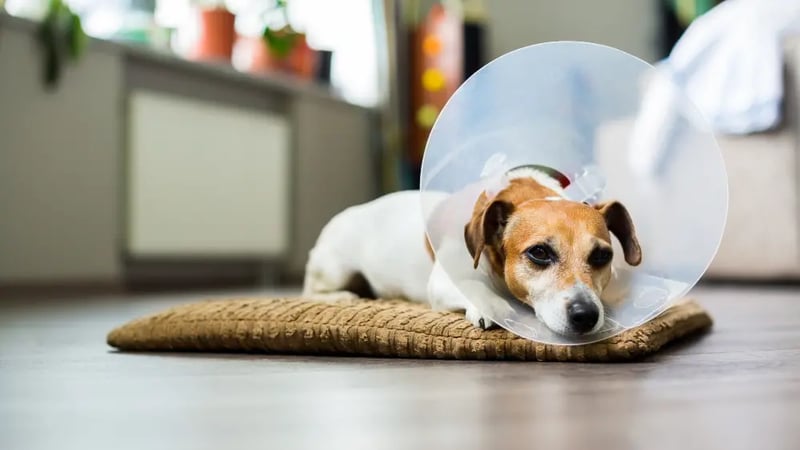
Many times, hot spots can be treated at home. However, it is very important to understand the cause of the dog's hot spot. The cause should always be identified in order to prevent further hot spots from happening, as well as to treat any underlying conditions.
To determine the underlying cause for overly infected hot spots on dogs, a trip to the vet is necessary.
It’s even more urgent if the affected area is:
-
- Increasing in size
- Consistently bleeding at the site of the hot spot.
- Coloured discharge
- You cannot keep your dog from scratching or licking the hot spot.
You should also seek veterinary attention sooner if you cannot keep your pet from licking/scratching it. Tools like a dog cone could help to prevent access to the area, but this may not work for all dogs.
How Does the Vet Treat Hot Spots in Dogs
If your dog hasn’t had a hot spot before, you may be curious about what the veterinarian will do. Depending on the severity of the hot spot, most vets will treat the area with an e-collar, give your pup anti-itch medication, and prescribe oral antibiotics.
The veterinarian may run tests or determine the underlying causes of the hot spot, which may require additional treatments or medication. Most commonly, these include allergy medication, flea prevention, ear medications, and more.
It’s important to get your pet veterinary care as soon as possible, so you can prevent further infection.
Home Remedies for Hot Spots on Dogs
If you aren’t able to get to the vet right away, there are a few things you can do at home to help heal hot spots.
Follow these steps to promote the healing of the hot spot:
- If necessary, use dog hair clippers to trim the fur around the hot spot. This allows the hot spot and affected areas to get air, which can prevent excess moisture that can hinder healing. Make sure not to use scissors- it may be likely that you will injure your dog since you can’t necessarily see how big the hot spot is under the hair.
- Clean the skin with a mild shampoo or water-based antibiotic.
- Apply a veterinary-recommended hot spot treatment spray.
- Keep an eye on the area to see signs of healing or to determine if additional treatment is necessary.
Best Products to Help Treat or Prevent Hot Spots on Dogs
Treating your dog’s hot spot is very important. If you want to treat it while waiting for the vet, have already seen the veterinarian, or have determined the underlying cause already, you can treat your dog’s hot spot with some of these products:
Earthbath Hot Spot Relief Shampoo
 Earthbath Hot Spot Relief Shampoo was designed with the health of your dog in mind. It’s a grooming solution that both soothes and treats hot spots and itchy, dry skin that are caused by various allergies, skin conditions, and bug bites. Aloe vera and tea tree oil are ointments that both soothe and rehydrate.
Earthbath Hot Spot Relief Shampoo was designed with the health of your dog in mind. It’s a grooming solution that both soothes and treats hot spots and itchy, dry skin that are caused by various allergies, skin conditions, and bug bites. Aloe vera and tea tree oil are ointments that both soothe and rehydrate.
This product is cruelty-free, and it won’t wash off any topical flick and tea treatments. You’ll love how there is no DEA, parabens, gluten, sulphates, synthetic dyes, or phthalates.
Burt's Bees for Dogs Soothing Hot Spot Spray
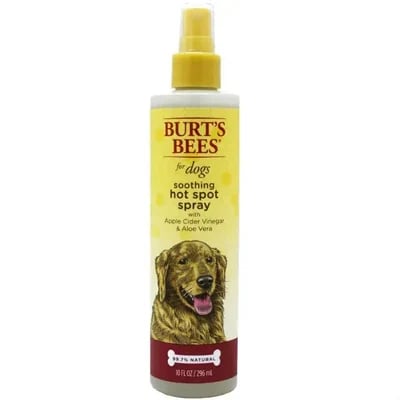
This spray is a great product that can help soothe your dog’s hot spots, scratching, and irritation of the skin. Burt's Bees Soothing Hot Spot Spray includes wholesome ingredients like apple cider vinegar, colloidal oatmeal, honey and aloe vera. These calm areas that are causing discomfort for your dog and speed up healing.
Additionally, this spray is non-toxic and cruelty-free. The spritz contains no artificial fragrances,
Skout’s Honor Probiotic Hot Spot Hydrogel
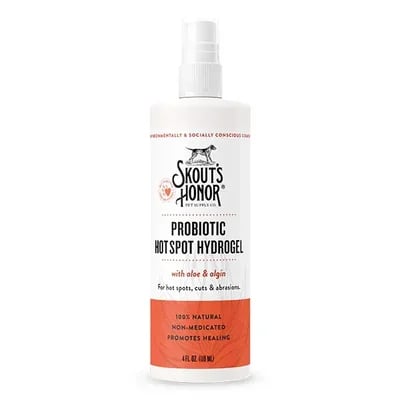
This non-medicated, vegan, cruelty-free, all-natural formulated spray uses live probiotic Kefir cultures. The natural ingredients will have you and your dog feeling great. Skout's Honor Hot Spot Hydrogel helps heal hot spots and other skin injuries.
The combination of hickory bark extract, aloe, and alginate with live probiotics moisturizes the area, protects the wound or hot spot from becoming infected and reduces the presence of bad bacteria. These help heal hot spots, abrasions, burns, skin irritation, and lacerations for both dogs and cats.
Vet's Best Hot Spot Spray
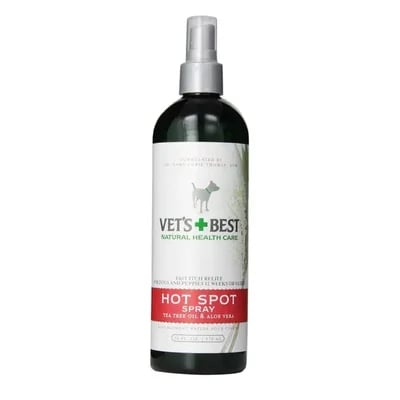
An all-natural solution to hot spots on dogs is Vet's Best Hot spot Spray. This gentle and soothing formula uses natural ingredients like tea tree oil, chamomile and aloe vera to soothe itch and irritation and condition the skin to speed up recovery.
Unlike some sprays, this alcohol-free formula won't sting, even on an open wound. Tea tree oil is a natural antiseptic to help eliminate bacteria and prevent infection.
How to Prevent Hot Spots on Dogs

The best way to prevent your dog from getting hot spots is to determine and treat the underlying cause.
Your veterinarian can help with this. It’s also important to practice good hygiene, such as keeping your dog current on his or her flea prevention, grooming him regularly, preventing ear infections, and treating allergies as they come.
You may not be able to completely prevent hot spots dogs, but these tips can help reduce the risk of them occurring!
Frequently Asked Questions
What are dog hot spots?
Dog hot spots, also known as acute moist dermatitis, are localized areas of inflamed and infected skin. They often appear as red, moist, and painful lesions on a dog's skin and can spread quickly.
What causes hot spots in dogs?
Hot spots can be triggered by various factors, including allergies, insect bites, poor grooming, skin infections, and underlying health issues. Scratching or licking a specific area excessively can also lead to hot spots.
How can I identify a hot spot on my dog?
Look for signs such as redness, swelling, hair loss, oozing discharge, and a foul odour in a specific area of your dog's skin. Hot spots are often itchy and painful, causing your dog to scratch or lick the affected area excessively.
What should I do if I suspect my dog has a hot spot?
If you suspect your dog has a hot spot, it's essential to consult with a veterinarian promptly. They can diagnose the condition, prescribe appropriate treatments, and recommend ways to prevent further hot spots.
How can I prevent hot spots in my dog?
To prevent hot spots, maintain good grooming habits, keep your dog's coat clean and dry, address any underlying allergies or skin issues, and prevent your dog from excessive scratching or licking through the use of an Elizabethan collar.
Can I treat my dog's hot spot at home?
Topical hot spot treatments can help to heal the spots quickly and reduce inflammation and irritation. Keep in mind that home remedies alone may not address the underlying cause or stop more hot spots from developing in the future.
.png?width=200&height=66&name=logo%20(1).png)



